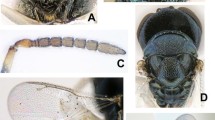Abstract
In the savanna around Lamto,Caryedon serratus develops, in the beginning of the dry season, on maturing seeds ofPiliostigma thonningii (Caesalpinioideae). A 2nd generation, and sometimes a 3nd one, develops in dry seeds. There is no pupal diapause during the rainy season and adults seems to spend this period in a semi-lethargic state. The parasitoid complex ofC. serratus is a chalcid-dominated one. It includes 5 species: one oophagous (Uscana caryedoni) and 4 larvo-nymphal parasitoids. Three species are regular (Anisopteromalus caryedophagus, Bracon sp. andU. caryedoni), the others are sporadic species (Proconura serratocida, Eurytoma caryedocida). Biological data are given for each species.
Résumé
Dans les savanes autour de Lamto,Caryedon serratus se développe, au début de la saison sèche, aux dépens de graines mûrissantes dePiliostigma thonningii (Casalpinioideae). Une 2e génération et quelquefois une 3e se développent dans des graines sèches. Il n'y a pas de diapause nymphale durant la saison humide et les adultes semblent passer celle-ci dans un état de quiescence. Le cortège parasitaire deC. serratus est dominé par les chalcidiens. Il comprend 5 espèces: une oophage (Uscana caryedoni) et 4 parasites larvo-nymphaux. Trois espèces sont régulières (Anisopteromalus caryedophagus, Bracop sp. andU. caryedoni), les autres sont des espèces sporadiques (Proconura serratocida, Eurytoma caryedocida). Nous donnons pour chaque espèce des données biologiques.
Similar content being viewed by others
References
Boucek, Z. — 1984. OnSchwarzella, Invreia and other Hybothoracini. —Boll. Lab. entomol. agr. Filippo Silvestri, 41, 53–63.
Cancela da Fonseca, J. P. — 1965. Oviposition and lengh of adult life inCaryedon gonagra (F.) [Col.: Bruchidae]. —Bull. Entomol. Res., 55, 697–707.
Conway, J. A. — 1975. Investigations into the origine, development and control ofCaryedon serratus [Col.: Bruchidae] attacking stored groundnuts in the Gambia. —Proc. 1st. Int. Working Conf. stored Prod. entomol. Savannah (Georgia), 554–566.
Davey, P. M. — 1958. The groundnut bruchid.Caryedon gonagra (F.). —Bull. Entomol. Res., 49, 385–404.
Decelle, J. — 1966.Bruchus serratus Ol., 1970, espèce type du genreCaryedon Schönherr, 1823. —Revue Zool. Bot. afr., 45, 172–192.
Decelle, J. — 1979. Fauna of Saudia Arabia I. Insects of Saoudi Arabia, Coleoptera: Fam.Bruchidae, 318–330.
Delobel, A. — 1988.Uscana caryedoni [Hym.: Trichogrammatidae]: possibilités d'utilisation en lutte biologique contre la bruche de l'arachide,Caryedon serratus [Col.: Bruchidae]. —Entomophaga, 34, 351–363.
Delvare, G. — 1988. Revision desEurytoma [Hym.: Eurytomidae] d'Afrique occidentale conservés au Muséum National d'Histoire Naturelle de Paris (Collection Risbec). —Ann. Soc. Entomol. Fr. (N. S.), 24, 117–149.
Donahaye, E., Navarro, S. &Calderon, M. — 1966. Observations on the life cycle ofCaryedon gonagra (F.) on its natural host in Israel,Acacia spirocarpa andA. tortilis. —Trop. Sci., 8, 85–89.
Gagnepain, C., Gillon, Y. &Leroux, J. M. — 1986.Caryedon serratus [Col.: Bruchidae] principal insecte consommateur des gousses dePiliostigma thonningii [Caesalpiniaceae] en savane de Lamto (Côte d'Ivoire). —Ann. Soc. Entomol. Fr. (N. S.), 22, 457–467.
Hanna, A. D. — 1934. The male and the female genitalia and the biology ofEuchalcidia caryobori Hanna [Hym.: Chalcididae]. —Trans. R. entomol. Soc. Lond., 82, 107–136.
Pfaffenberger, G. S. — 1984. Description of first instar larva ofCaryedon palaestinicus Southgate, new status [Coleoptera: Bruchidae]. —The Coleopt. Bull., 38, 220–226.
Pollet, A. — 1984. Caractérisation des stocks villageois de Légumineuses à graines constitués en Côte d'Ivoire (arachide, niébé et pois bambara). Identification des principaux ravageurs et problèmes posés par la production. Enquête CIDT et IDESSA-ORSTOM, campagne 1983–1984. —Ronéo. RSTOM, 39 p.
Prevett, P. F. — 1966. Observations on the biology in the genusCaryedon Schönherr [Coleoptera: Bruchidae] in Northern Nigeria, with a list of associated parasitic Hymenotpera. —Proc. R. entomol. Soc. Lond. (A) 41, 9–16.
Rasplus, J. Y. — 1988. La communauté parasitaire des coléoptères séminivores de légumineuses dans une mosaïque forêt-savane en Afrique de l'Ouest (Lamto, Côte d'Ivoire). —Thèse de Doctorat, Université d'Orsay Paris XI, 1–437.
Risbec, J. — 1950. La faune entomologique des cultures au Sénégal et au Soudan français. —Trav. Lab. Entomol. Secteur Soudanais Rech. Agron., 1–639.
Risbec, J. — 1951. Les Chalcidoïdes d'A.O.F. —Mem. Inst. Fr. Afr. noire, 13, 1–409.
Risbec, J. — 1960. les parasites des insectes d'importance économique en Afrique tropicale et à Madagascar. —Agron. trop., 15, 623–656.
Sohi, G. S. — 1940.Pachymerus gonagra as a store pest. —Indian J. Entomol., 2, 244.
Steffan, J. R. — 1976. LesEuchalcidia Masi du bassin méditerranéen, [Hym.: Chalcididae]. —Bull. Soc. Entomol. Fr., 81, 52–63.
Steffan, J. R. — 1981. The parasites of bruchids. — La Hague,Series Entomologica, 19, 223–229.
Author information
Authors and Affiliations
Rights and permissions
About this article
Cite this article
Gagnepain, C., Rasplus, J.Y. Caryedon serratus and its parasitoids in the Savanna around Lamto, Ivory Coast. Entomophaga 34, 559–567 (1989). https://doi.org/10.1007/BF02374394
Received:
Accepted:
Issue Date:
DOI: https://doi.org/10.1007/BF02374394



